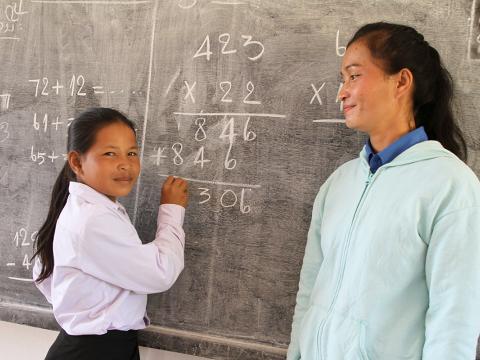A stronger school for brighter future

From Monday to Friday, the new primary school in Khokhuaxang village is filled with happy children who are eager to learn. The new building hosts 52 students from grade 1 to grade 5, taught by 3 teachers. Grades 3 and 4 are excited to see teacher Souksamai, who takes around 30min from her hometown to come and teach every day.
Souksamai is 34 years old and has been teaching for nine years. She saw the evolution of what she calls her “second house”. She says:
A few years ago, the school building was old, with dust floor, bamboo walls and a leaking roof. In case of rain or strong wind, we needed to stop teaching because it was dangerous for both students and teachers. The school furniture was built as traditional and there was not enough for students to sit. We needed to repair it every year before the opening of the new term.
Very prone to natural disasters over the past years, Xonnabuly district was affected by a tropical storm in late 2020. Recurrent hazards that unfortunately didn’t leave the old school of Khokhuaxang village behind, putting children away from school for a while. Souksamai says: “during the last flooding, our school building and furniture were destroyed and covered by the mud. It took around two months to recede the mud and to operate again, but there was no safety for students and teachers.”
In the aftermath of the flood, World Vision supported the construction and renovation of four primary schools affected by natural disasters in Xonnabuly district, Savannakhet province, with the support of World Vision Singapore. Quick support for an immediate impact on the daily life of the children: “we have a new and beautiful school building. I feel more comfortable when I am sitting to study, and I feel safer than before” said Sara, a 10-year-old girl, studying in primary school grade 5.
With a stronger school, quality education is now possible in Khokhuaxang village. However, historical challenges are impacting the intellectual development of the children in the community. Teacher Souksamai says: “some parents weren’t fully supporting their children going to school because they wanted help on the farm”. To ensure this new opportunity overcomes the challenges faced in the past, World Vision teams raised awareness among students and parents on the importance of education. This initiative led many families to prioritize children’s education.
Additional inputs from the project, such as training of the teachers, provision of learning materials, school furniture and installation of handwashing stations, water supplies, and toilets are new factors improving the studying conditions of the pupils, new reasons for them to attend school. Those are also new reasons for Souksamai to enjoy teaching: “I also attended the training on how to improve teaching and learning skills.
I love being a teacher. My dream is to see the students, especially in rural areas, reach their potential and have a good future.